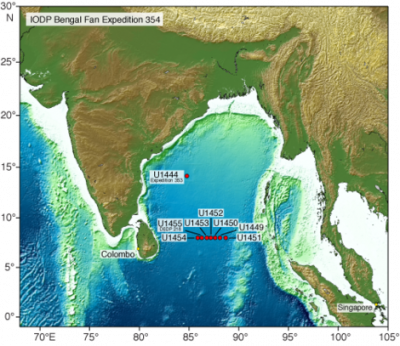Page path:
- Organic Geochemistry
- Projects
- Hinrichs Lab - Bengal Fan
Hinrichs Lab - Bengal Fan

Subseafloor life and carbon cycling in the Bengal Fan (IODP Exp. 354)
| Duration: | August 2016 - July 2018 |
| Funding: | Deutsche Forschungsgemeinschaft (DFG) Schwerpunktprogramm 527 "Integrated Ocean Drilling Program/Ocean Drilling Program (IODP/ODP)" |
| Principal Investigator: | Rishi Ram Adhikari |
| Involved scientists in the Hinrichs Lab: | Kai-Uwe Hinrichs, Verena Heuer |
| Partner: | Fumio Inagaki (Japan Agency for Marine-Earth Science and Technology, Kochi Institute for Core Sample Research, Kochi, Japan) |
Abstract
Covering the entire Bay of Bengal, the Bengal Fan is one of the largest sediment reservoirs in the world and provides a geological record for Himalayan orogeny. Since the collision between India and Eurasia initiated mountain building processes ~ 50-55 Ma ago, the rapid rise of the Himalaya from the lowlands of northern India and the high elevation of the Tibetan plateau must have profoundly affected the temperature structure of the atmosphere and thus seasonal winds, precipitation and the development of the Asian monsoon, which ultimately drive surface weathering, erosion and fluvial transport. Such tectonics-climate interactions potentially influence the global carbon cycle by two mechanisms that move carbon from the atmosphere to the sedimentary reservoir, i.e. by weathering of silicates which produces fluvial alkalinity that can later precipitate as carbonate in seawater, and by fluvial transport of plant debris and other continent-derived organic matter (OM) and subsequent long-term burial of these particles within the deep-sea fan. This is particularly true for the Bengal Fan, which receives one of the highest fluxes of terrestrial OM to the ocean. The relatively high sediment accumulation rates (a few centimeters to 20-25 cm/ky) are thought to promote the preservation of sedimentary OM.
In order to elucidate the impact of Himalayan orogeny on the global carbon cycle, it is important to understand how the microbial activity of the deep biosphere is intertwined with the preservation or remineralization of sedimentary OM as well as with changes in sediment supply. Two aspects deserve particular attention: On the one hand, variations in organic carbon accumulation rate over geological time scales affect the energy supply of the deep biosphere as well as the amount of CO2 in the atmosphere, and thus climate. On the other hand, Himalayan orogeny might have shaped the development of the deep biosphere in the Bengal Fan by riverine transport of terrestrial sediments and associated nutrients and microorganisms from the Ganga-Brahmaputra catchment into the Bay of Bengal.
In February-March 2015, International Ocean Discovery Program (IODP) Expedition 354 drilled a transect of seven sites in the Bay of Bengal along 8°N latitude to study interactions between tectonics, climate change and the global carbon cycle in the late Paleogene and Neogene. The expedition provided a much longed-for opportunity to conduct deep biosphere research in the Indian Ocean with state-of-the-art and novel techniques. To date, information on this part of the global ocean is scarce in the evolving picture of the deep subseafloor biosphere. The main knowledge on the deep biosphere in this region is derived from previous drilling with DV JOIDES Resolution in the framework of the Indian National Gas Hydrate Program Expedition 01. PI sailed as shipboard scientist on Exp. 354 and obtained a set of dedicated high-quality samples for post-cruise research aiming to address questions in accordance with the fundamental challenges identified in the IODP Science Plan (ISP) for the period 2013-2023:
In February-March 2015, International Ocean Discovery Program (IODP) Expedition 354 drilled a transect of seven sites in the Bay of Bengal along 8°N latitude to study interactions between tectonics, climate change and the global carbon cycle in the late Paleogene and Neogene. The expedition provided a much longed-for opportunity to conduct deep biosphere research in the Indian Ocean with state-of-the-art and novel techniques. To date, information on this part of the global ocean is scarce in the evolving picture of the deep subseafloor biosphere. The main knowledge on the deep biosphere in this region is derived from previous drilling with DV JOIDES Resolution in the framework of the Indian National Gas Hydrate Program Expedition 01. PI sailed as shipboard scientist on Exp. 354 and obtained a set of dedicated high-quality samples for post-cruise research aiming to address questions in accordance with the fundamental challenges identified in the IODP Science Plan (ISP) for the period 2013-2023:
- What are the origin, composition, and global significance of subseafloor communities? (Challenge 5)
- How sensitive are ecosystems and biodiversity to environmental change? (Challenge 7)
- What properties and processes govern the flow and storage of carbon in the subseafloor? (Challenge 13)



